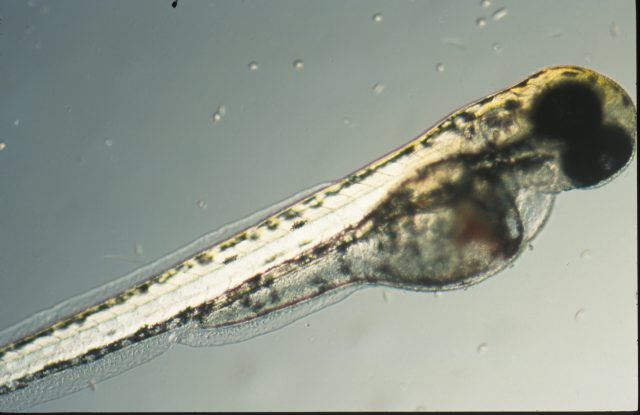Zebrafish: The next “big” thing in drug discovery
Think about a laboratory animal. Have you drawn a mouse in your mind? Perhaps a monkey? I would bet that you had not thought about fish and even less about fish larvae. But, indeed, they are potential animal models for drug discovery, especially the Danio rerio species, better known as zebrafish.

As you can imagine, replacing bigger vertebrates by small fish larvae implies several advantages for drug research. Since these larvae weigh around one thousandth of rice grain and they grow fast, a huge amount of them can be raised at relatively cheap cost. Not to mention that the experimentation with this kind of animals involves less ethical issues in comparison to higher level vertebrates. In terms of disease studies, zebrafish can be genetically manipulated and therefore the illness that we want to study can be easily induced. And there is still more wonder: zebrafish embryos are transparent! This means that the metabolism or disease process can be in-vivo tracked by using fluorescence markers.

But, could any fish larva be used as animal models for humans? What makes zebrafish so suitable for drug research? The answer is in the genes. Even if the phenotypes of zebrafish and humans are blatantly different, 70% of human genes have at least one zebrafish ortholog and, therefore, the resemblance in drug response is high.1
Thus, the use of zebrafish as animal model is a potential alternative to replace other vertebrates but, as usual, it is not as easy as it could seem. How can we expose such tiny larvae to drugs? How can we measure the trace level concentrations of drugs and metabolites? Can we extrapolate the distribution and elimination models to humans? In order to answer these questions, the Division of Analytical Biosciences the Division of Pharmacology in the Leiden Academic Centre for Drug Research and the Institute of Biology Leiden joined efforts to develop the first pharmacokinetics (PK) model in zebrafish larvae by using paracetamol as paradigm drug2. Then, they translated the results obtained from the PK model to humans and compared them with previous experimental values obtained for other vertebrates.
The starting point of this research was to study the drug exposure, metabolism and the elimination of the drug in zebrafish larvae employing two different experiments. First, 3dpf (days post fertilization) zebrafish larvae were exposed at different times to an embryo medium containing paracetamol. After exposing and washing the larvae, the amount of drug and drug metabolites inside them was quantified in order to know how much drug had been absorbed and metabolized. Taking these results into consideration, a second experiment was carried out to study drug elimination. Larvae exposed to paracetamol were washed and transferred to drug free medium where they were kept for different times. Again, larvae (and also incubation medium) were analysed. As you can guess, these analyses require a very sensitive analytical method capable of quantifying paracetamol and its metabolites (paracetamol sulphate and paracetamol glucuronide) in extremely low concentrations (pM range). Using a state-of-the-art Ultra High Performance Liquid Chromatography – Time of Flight Mass Spectrometry technology, these small concentrations could be quantified.
Once the concentration of paracetamol and its metabolites was determined for the absorption and the elimination experiments, a nonlinear mixed effects modelling was performed to study the PK of the drug. Among the several PK parameters the clearance of the paracetamol was calculated which can be defined as the volume of the fluid cleared of drug from the body per unit of time, both by excretion and metabolism.
The calculated clearance value for paracetamol was compared with the data reported over the last 10 years for different vertebrates such as mice, rats, rabbits, pigs, monkeys and obviously humans. With this aim, the clearance values obtained in the literature were plotted against the bodyweight of the different animal species so that an allometric relationship between these two factors could be built. Considering the bodyweight of the zebrafish larvae (around 0.3 mg), which is five orders magnitude lower than the lowest vertebrate (mice), the expected clearance value was calculated and it turned to be slightly higher than the one obtained using the PK model. So, where was the problem?
The relationship between bodyweight and clearance was done using only data from mature animals, as soon as the clearance values reported for immature individuals of the higher vertebrates were included; the underestimation of the clearance value was corrected. This fact might indicate that at the third day of post-fertilization larvae are not fully developed and reflect better the PK of immature population (children) than adult population. In fact, the quantitative results showed a higher concentration of the sulphate metabolite compared to the glucuronide one, as happens in human new-borns, where glucuronidation capacity is limited.
This study is another step forward in the field of drug discovery using zebrafish. An animal model that is becoming one of the most prominent ones and whose capabilities have to be further explored.
Acknowledgments:
The author thanks the Leiden Academic Centre for Drug Research and the Division of Analytical Bioscience directed by Thomas Hankemeier, especially Vasudev Kantae, for his support with this article.
References
- Howe K. et al. The zebrafish reference genome sequence and its relationship to the human genome. Nature. 496(7446): 498–503 (2013). doi: 10.1038/nature12111 ↩
- Kantae V., Krekels E.H.J., Ordas A., González O., van Wijk R.C., Harms A.C., Racz P.I., van der Graaf P.H., Spaink H.P., and Hankemeier T. Pharmacokinetic Modeling of Paracetamol Uptake and Clearance in Zebrafish Larvae: Expanding the Allometric Scale in Vertebrates with Five Orders of Magnitude. Zebrafish.13(6): 504-510 (2016). doi:10.1089/zeb.2016.1313. ↩
1 comment
[…] El pez cebra puede ser el animal-modelo con el que se descubran los fármacos del futuro. Oskar González en Zebrafish: The next “big” thing in drug discovery […]